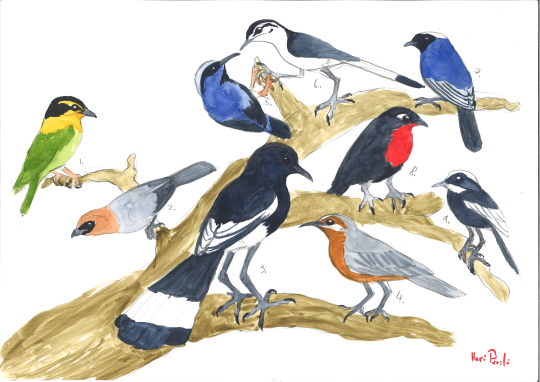#Sororavis
Explore tagged Tumblr posts
Text
Fossil Novembirb: Day 9 - Getting a grip

Passeriform birds are by far the most species rich bird group today, representing half of all birds (That's about 6,000 species), which is utterly wild. But before true passerines, birds in the stem-passerine lineage were already diversifying into all sorts of niches. They are equally close relatives to parrots and passeriforms, as can be seen from their passeriform-like bodies and beaks as well as their parrot-like zygodactyl feet. They were likely a big part of the Paleogene morning chorus.
Eofrillingirostrum: This Psittacopedid bird had a strong finch-like beak that was used in eating hard seeds. It lived during the early Eocene of Europe and North America.
Parapsittacopes: Another member of psittacopedes, this bird had a short beak used to eat fruit and berries. It lived 50 million years ago, and its fossils were found in the London Clay formation.
Eozygodactylus: This large member of the Zygodactylid family had long legs with parrot-like feet. These birds lived in North America during the early Eocene, 50 million years ago.
Sororavis: This rather strange member of the stem-passeriforms was found from the Fur Formation of Denmark, around 50 million years ago.
Pumiliornis: A long beaked stem-passeriform from Messel lake, around 40 million years ago. It was the first known bird to have eaten nectar, using its long beak to get it from flowers.
Primozygodactylus: Another member of the Zygodactylid group which lived all over Europe during the Eocene, but is best known from Messel Lake.
Psittacopes: A Psittacopedid bird with short legs and parrot-like feet. This frugivorous bird lived in many parts of Europe during the Eocene.
Psittacomimus: A Psittacopedid bird from the London Clay formation, this bird had zygodactyl feet like parrots as well as a short, rounded beak for eating seeds and fruit.
Zygodactylus: One of the smaller members of the long legged zygodactylids. It was a very successful bird, as its remains have been found from Europe and North America, and it persisted from the early Eocene to the Oligocene.
#Fossil Novembirb#Novembirb#Dinovember#birblr#palaeoblr#Birds#Dinosaurs#Cenozoic Birds#Eofrillingirostrum#Parapsittacopes#Eozygodactylus#Sororavis#Pumiliornis#Primozygodactylus#Psittacopes#Psittacomimus#Zygodactylus
53 notes
·
View notes